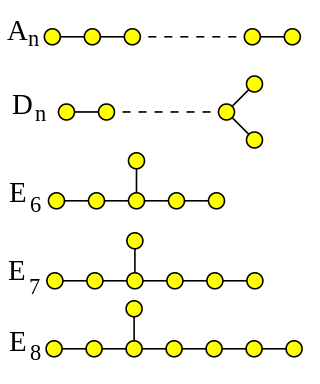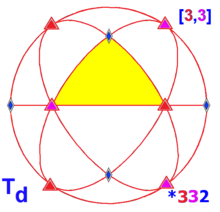
In abstract algebra, the symmetric group defined over any set is the group whose elements are all the bijections from the set to itself, and whose group operation is the composition of functions. In particular, the finite symmetric group defined over a finite set of symbols consists of the permutations that can be performed on the symbols. Since there are such permutation operations, the order of the symmetric group is .
In linear algebra, an orthogonal matrix, or orthonormal matrix, is a real square matrix whose columns and rows are orthonormal vectors.

In mathematics, the orthogonal group in dimension n, denoted O(n), is the group of distance-preserving transformations of a Euclidean space of dimension n that preserve a fixed point, where the group operation is given by composing transformations. The orthogonal group is sometimes called the general orthogonal group, by analogy with the general linear group. Equivalently, it is the group of n × n orthogonal matrices, where the group operation is given by matrix multiplication (an orthogonal matrix is a real matrix whose inverse equals its transpose). The orthogonal group is an algebraic group and a Lie group. It is compact.
In mathematics, specifically group theory, the index of a subgroup H in a group G is the number of left cosets of H in G, or equivalently, the number of right cosets of H in G. The index is denoted or or . Because G is the disjoint union of the left cosets and because each left coset has the same size as H, the index is related to the orders of the two groups by the formula
In mathematics, a generalized permutation matrix is a matrix with the same nonzero pattern as a permutation matrix, i.e. there is exactly one nonzero entry in each row and each column. Unlike a permutation matrix, where the nonzero entry must be 1, in a generalized permutation matrix the nonzero entry can be any nonzero value. An example of a generalized permutation matrix is

In mathematics, in particular the theory of Lie algebras, the Weyl group of a root system Φ is a subgroup of the isometry group of that root system. Specifically, it is the subgroup which is generated by reflections through the hyperplanes orthogonal to the roots, and as such is a finite reflection group. In fact it turns out that most finite reflection groups are Weyl groups. Abstractly, Weyl groups are finite Coxeter groups, and are important examples of these.
In mathematics, a Coxeter group, named after H. S. M. Coxeter, is an abstract group that admits a formal description in terms of reflections. Indeed, the finite Coxeter groups are precisely the finite Euclidean reflection groups; for example, the symmetry group of each regular polyhedron is a finite Coxeter group. However, not all Coxeter groups are finite, and not all can be described in terms of symmetries and Euclidean reflections. Coxeter groups were introduced in 1934 as abstractions of reflection groups, and finite Coxeter groups were classified in 1935.

In mathematics, the ADE classification is a situation where certain kinds of objects are in correspondence with simply laced Dynkin diagrams. The question of giving a common origin to these classifications, rather than a posteriori verification of a parallelism, was posed in. The complete list of simply laced Dynkin diagrams comprises

In geometry, a cross-polytope, hyperoctahedron, orthoplex, or cocube is a regular, convex polytope that exists in n-dimensional Euclidean space. A 2-dimensional cross-polytope is a square, a 3-dimensional cross-polytope is a regular octahedron, and a 4-dimensional cross-polytope is a 16-cell. Its facets are simplexes of the previous dimension, while the cross-polytope's vertex figure is another cross-polytope from the previous dimension.
In group theory, restriction forms a representation of a subgroup using a known representation of the whole group. Restriction is a fundamental construction in representation theory of groups. Often the restricted representation is simpler to understand. Rules for decomposing the restriction of an irreducible representation into irreducible representations of the subgroup are called branching rules, and have important applications in physics. For example, in case of explicit symmetry breaking, the symmetry group of the problem is reduced from the whole group to one of its subgroups. In quantum mechanics, this reduction in symmetry appears as a splitting of degenerate energy levels into multiplets, as in the Stark or Zeeman effect.

In mathematics, and especially in geometry, an object has icosahedral symmetry if it has the same symmetries as a regular icosahedron. Examples of other polyhedra with icosahedral symmetry include the regular dodecahedron and the rhombic triacontahedron.

A regular octahedron has 24 rotational symmetries, and 48 symmetries altogether. These include transformations that combine a reflection and a rotation. A cube has the same set of symmetries, since it is the polyhedron that is dual to an octahedron.
In mathematics, the binary icosahedral group 2I or ⟨2,3,5⟩ is a certain nonabelian group of order 120. It is an extension of the icosahedral group I or (2,3,5) of order 60 by the cyclic group of order 2, and is the preimage of the icosahedral group under the 2:1 covering homomorphism
In projective geometry and linear algebra, the projective orthogonal group PO is the induced action of the orthogonal group of a quadratic space V = (V,Q) on the associated projective space P(V). Explicitly, the projective orthogonal group is the quotient group

In eight-dimensional geometry, an eight-dimensional polytope or 8-polytope is a polytope contained by 7-polytope facets. Each 6-polytope ridge being shared by exactly two 7-polytope facets.

In nine-dimensional geometry, a nine-dimensional polytope or 9-polytope is a polytope contained by 8-polytope facets. Each 7-polytope ridge being shared by exactly two 8-polytope facets.

In geometry, demihypercubes (also called n-demicubes, n-hemicubes, and half measure polytopes) are a class of n-polytopes constructed from alternation of an n-hypercube, labeled as hγn for being half of the hypercube family, γn. Half of the vertices are deleted and new facets are formed. The 2n facets become 2n(n−1)-demicubes, and 2n(n−1)-simplex facets are formed in place of the deleted vertices.
In mathematics, the binary octahedral group, name as 2O or ⟨2,3,4⟩ is a certain nonabelian group of order 48. It is an extension of the chiral octahedral group O or (2,3,4) of order 24 by a cyclic group of order 2, and is the preimage of the octahedral group under the 2:1 covering homomorphism of the special orthogonal group by the spin group. It follows that the binary octahedral group is a discrete subgroup of Spin(3) of order 48.
In mathematics, the generalized symmetric group is the wreath product of the cyclic group of order m and the symmetric group of order n.

In geometry, Coxeter notation is a system of classifying symmetry groups, describing the angles between fundamental reflections of a Coxeter group in a bracketed notation expressing the structure of a Coxeter-Dynkin diagram, with modifiers to indicate certain subgroups. The notation is named after H. S. M. Coxeter, and has been more comprehensively defined by Norman Johnson.






































